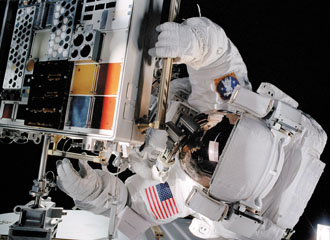Research in the Final Frontier
 |
Astronaut Patrick G. Forrester prepares to work with the Materials International Space Station Experiment (MISSE) during the second STS-105 extravehicular activity. The experiment was installed on the outside of the Quest Joint Airlock during the first extravehicular activity of the STS-105 mission. MISSE will collect information on how different materials weather in the environment of space. |
Nestled deep inside NASA’s
The Human Spaceflight Payloads Office is an Air Force Space Command operating location of the Space Development Group, Space Development and Test Wing. The Space Development Group commander is dual-hatted, also serving as the director of the Defense Department’s Space Test Program (STP). Each year, the Defense Department Space Experiments Review Board (SERB)—made up of representatives from the various military services—sends the STP a list of experiments that military services and agencies want flown in space.
Military services and agencies prioritize their needs before submitting them to the review board, and then SERB applies its priority order to the submissions annually before turning them over to the STP. Once STP personnel receive them, the organization’s mission design team performs a mission design analysis that determines the highest likelihood for success: flying on the space shuttle, flying to the International Space Station (ISS) or using an expendable launch vehicle. Launches depend on priority and funding. Per STP directive, the experimental payloads can be operated for up to a year on-orbit or until the science objectives are achieved, whichever comes first, except in a few cases of extenuating circumstances.
Col. Stephen Hargis, USAF, director of the STP, and commander, Space Development Group at the Space Development and Test Wing, explains that budget limits form part of the reason payloads can fly for only one year. Flying longer would eat into funding and reduce the number of experiments the program could put into space. Another factor is that longer flights would make them operational, not experimental. “Getting in as many flights as possible is our goal,” he says. To realize as many experiments as they can, personnel sometimes look outside NASA and even the
As part of the mission decision process, personnel have to determine which experiments need manned flights. Craig Lamb, the deputy director of the Human Spaceflight Payloads Office, says that certain experiments can be done only with a space shuttle ride. For example, a study done on tissue loss in space required researchers to transport samples back and forth. Lamb explains that the process would be difficult with an expendable launch vehicle.
The experiment list for fiscal year 2010 has 63 experiments, and officials with the STP expect to put 20 percent of those into space. Last year, approximately 15 percent was accomplished. Because of the limited budgets as well as space constraints and other factors, experiments with a lower priority could fly before higher priority experiments. Officials also sometimes bundle experiments into a single payload to achieve more efficiency.
Though the military initiates and funds experiments, the mission of the Human Spaceflight Payloads Office is related solely to science and technology with no military operational role in the traditional sense. It serves as the military’s primary interface with NASA to attain flight for Defense Department technologies on human-rated launch vehicles or to human-rated platforms, specifically the ISS.
Program personnel work hand-in-hand with NASA counterparts to determine several factors prior to manifesting a payload, including safety, availability and schedule. Officials must determine, based on priority, if sufficient space exists on board a shuttle and if payloads fall within weight margins. They also must decide if payloads satisfy all safety and integration processes within a certain time frame to meet the launch schedule.
One of the biggest challenges the Human Spaceflight Payloads Office encounters is safety. The missions must meet stringent human-rated safety requirements to protect astronauts and vehicles. The safety requirements and integration processes followed by the office are unique in the military, and maintaining a skill base that understands them is another challenge. In addition to active duty and civilian Air Force personnel, staff members from the Aerospace Corporation, the Space Dynamics Lab,
According to Col. Hargis, this unit is the only place these processes can be learned, and it is all on-the-job training. “Therefore this is an extremely challenging assignment from the day the new troop walks in the door,” he says. The military engineers benefit from the skills learned at the
Despite the lack of direct support to military missions, the technologies flown jointly with NASA benefit future military and NASA operations by demonstrating space capabilities of future sensors, materials and concepts of operation. And though experiments might not impact defense forces immediately, the studies can result in items for use on the battlefield. One such product is the chitosan bandage, an improved version of the compound used in the blood-clotting bandage. “The chitosan bandage is a key lifesaver for our injured warfighters,” Col. Hargis says.
 |
The exterior of the Japanese Kibo complex of the International Space Station (ISS) and the station’s Canadarm2 are visible in this photograph by an Expedition 20 crew member on the station. European Space Agency astronaut Frank De Winne and NASA astronaut Nicole Stott, both Expedition 20 flight engineers, used the controls of the Japanese Experiment Module Remote Manipulator System in Kibo to grapple and transfer two payloads—the Hyperspectral Imager for the Coastal Ocean Remote Atmospheric and Ionospheric Detection System, and the Superconducting Submillimeter-wave Limb-emission Sounder—from the Exposed Pallet to their exposed facility locations. |
During research, the STL hardware demonstrated a capability to supply nutrients to the cells intravenously in the microgravity environment. This demonstration led to a miniature infusion pump that is small and lightweight. The intravenous pump requires low power, creating minimal impedance to the wounded soldier and enhanced combat casualty care.
Other experiments have different motives. The Hyperspectral Imager for the Coastal Ocean (HICO)Remote Atmospheric and Ionospheric Detection System (RAIDS) Experiment Payload (HREP) consists of two separate experiments and the flight support equipment connecting them to the space station. RAIDS aims to obtain a complete description of the major constituents of the thermosphere and ionosphere at altitude. HICO’s goal is to demonstrate a maritime hyperspectral imaging system for the detection, identification and quantification of littoral and terrestrial geophysical features. The Office of Naval Research and the STP both contributed funds to cover the costs for the design, assembly and testing of the HREP instrument enclosure. Supported by NASA, the STP selected the experiment payload to be the first
Another payload on the space station is the Synchronized Position, Hold, Engage, Reorient Experimental Satellites, or SPHERES. This payload offers a technology demonstration for 3-D satellite constellation control. Researchers have conducted more than 19 test sessions aboard the space station. The projects evaluate software for autonomous formation flight of multiple satellites. According to the program officials, this is a key capability that will be needed to safely operate future satellite systems in space.
The SPHERES time frame differs slightly from other payloads. Because of the nature of the research, and as approved by the SERB, the experiment is being flown on the ISS longer than one year. SPHERES test sessions normally take three to four hours each and are dependent on crew availability. To achieve the requested number of science sessions of the necessary duration, each requires more than one calendar year. The extra time is supportable, because the operations are not continuous.
In the Materials International Space Station Experiment (MISSE), researchers are testing advanced materials and electronics attached to the outside of the station. The results will offer a better understanding of the durability of advanced materials and electronics when exposed to vacuum, solar radiation, atomic oxygen and temperature extremes. “These materials and electronics, including solar cells, coatings, thermal protection, optics, sensors and computing elements, have the potential to increase the performance and useful life of the next generation of satellites and launch systems,” Col. Hargis says. “Another key benefit of STP performing the MISSE missions is that it saves DOD and NASA spacecraft designers millions of dollars by reducing risk associated with developing and choosing materials, electronics, et cetera, for each individual mission.” The MISSE program has flown and evaluated approximately 4,000 items.
Different materials and experiments are launched on each MISSE mission. The most recent mission—MISSE 7—went up last November. Each MISSE experiment typically will last less than a year on-orbit, which is sufficient time for the materials and experiments to gather the space exposure data needed.
Col. Hargis shares that examples of success date from way back, saying the STP has been at the core of military and
Dave Hess, the director of the Human Spaceflight Payloads Office, emphasizes that the work his office does saves lives. He compares the casualty numbers in World War II and
Results from the various experiments are reported back through the STP within six months to a year of completing the science objectives. If any surprises occur from the experimenters’ analysis, it is the researchers’ prerogative to share that information with the space testing offices, whether it be the human payload office or otherwise.
The space research offices encounter few surprises because in their roles they integrate and operate each experiment to acquire the maximum amount of science for the sponsor. Therefore, each process is very detailed and personnel seldom encounter the unexpected as they prepare for virtually every contingency. However, during an experiment to measure atmospheric density, researchers did encounter an exception and did find an unexpected result.
A goal of the effort was to observe the large changes in the atmosphere that occur during active geomagnetic periods; however there was very little activity during the entire mission. The data from the experiment shows that the standard climatological density models are overestimating the atmospheric density by 25 percent. “This finding was unexpected although the current solar minimum [period of least sunspot and solar flare activity] has been full of surprises,” Col. Hargis states.
WEB RESOURCES
Space Development and Test Wing: www.kirtland.af.mil/library/factsheets/factsheet.asp?id=6881
Japan Aerospace Exploration Agency: www.jaxa.jp/index_e.html




Comments